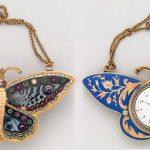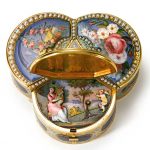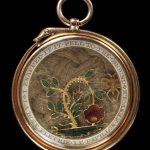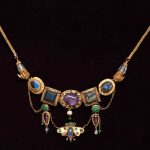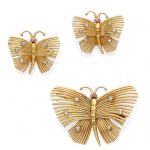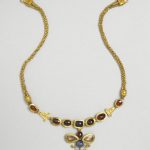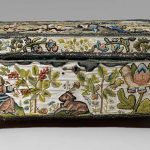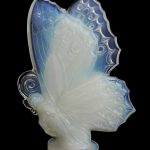Gold Butterflies. Gold is a chemical element with the symbol Au and atomic number 79, making it one of the higher atomic number elements that occur naturally. In its purest form, it is a bright, slightly reddish yellow, dense, soft, malleable, and ductile metal. Chemically, gold is a transition metal and a group 11 element. Reference: Wikipedia
The first firm evidence of human interaction with gold occurred in ancient Egypt around 3,000 B.C. Gold played an important role in ancient Egyptian mythology and was prized by pharaohs and temple priests. It was so important, in fact, that the capstones on the Pyramids of Giza were made from solid gold. Reference: BeBusinessed
Below are some examples of gold objects with butterflies in their design including a Roman gold butterfly necklace.
Watch in the form of a butterfly ca. 1840–50 Swiss
Case of gold, enamel, and pearls
Reference: The Metropolitan Museum of Art
The See-Saw A GOLD ENAMEL AND PEARL TREFOIL MUSICAL AUTOMATON SNUFF BOX WITH WATCH FOR THE CHINESE MARKET THE MOVEMENT ATTRIBUTED TO PIGUET & CAPT GENEVA WITH BOX MAKERS’ MARKS FOR RÉMOND, LAMY, MERCIER & CO., 1804-1811 • the box composed of three compartments, hinged lids decorated with flowers and trophies on opaque powder blue enamel, centered by a pearl-set flower head and graduated split pearl border • the automata depicting Cupid teetering on a moving see-saw balanced by a gold butterfly, to the left a lady strums the lyre against a polychrome enamel lake scene, the lid with trophy of love and time covering a pair of white enamel chapter rings, for hours and minutes, and another for seconds, above regulator arc on gold engine-turning • the lid of summer flowers lifting to reveal snuff compartment, the base with a bouquet of polychrome flowers on scalloped opaque blue panel surrounded by translucent blue on a rayed ground all within a border of chased leaves and red enamel flower heads on a turquoise ground, the sides with blue enamel reserves surrounded by champlevé turquoise formal foliage • the music work with two set of stacked blades • two interior lids stamped with box makers’ mark IGRC, in a horizontal lozenge for Rémond, Lamy & Mercier & Co., and PC script, a 3 between
Sold for 298,000 USD at Sotheby’s in 2015
Gold locket, the frame edged with a serpent enclosing a drooping rose bush and a butterfly in enamelled gold on a background of plaited hair, surrounded by the inscription La Rose Flétrie le Papillon s’Envole ( translated as The rose withers, the butterfly flies away and I snapped it, it fell to the ground. Engraved on the backAnd such I exclaim’d is the pitiless part, some art by the delicate Mind, Regardless of Wringing and Breaking a Heart, already to sorrow resigned.
The Victorians continued the custom of using hair jewellery in gifts of love and remembrance. Queen Victoria both wore and gave jewellery set with hair. Hair curls were set in more modest mounts than before.
Reference: © Victoria and Albert Museum
Necklace with Butterfly Pendant Elaborate diadems or necklaces featuring centerpieces of inlaid stones, pendants, and beaded chains go back to 3rd- and 2nd-century Greek jewelry. This necklace was found on the neck of the deceased; as the symbol of the soul, the butterfly was an appropriate motif for a burial gift.
Medium gold, amethyst, chalcedony, emerald, rock crystal, pearl, and colored glass
Reference: The Walters Art Museum
A diamond and ruby butterfly brooch and ear clip set mounted in 18k gold; gross weight approximately: 28 grams; brooch dimensions: 1 3/4 x 2in.; ear clip dimensions: 1 1/8 x 1 1/4in.
Sold for US$ 4,075 (£ 3,305) inc. premium at Bonham’s in 2019
Plaited gold necklace decorated with precious stones in the form of a butterfly; the head is a garnet, the body is a sapphire and two white stones form the wings.
Roman 1st Century – 2nd Century
Reference: © The Trustees of the British Museum

